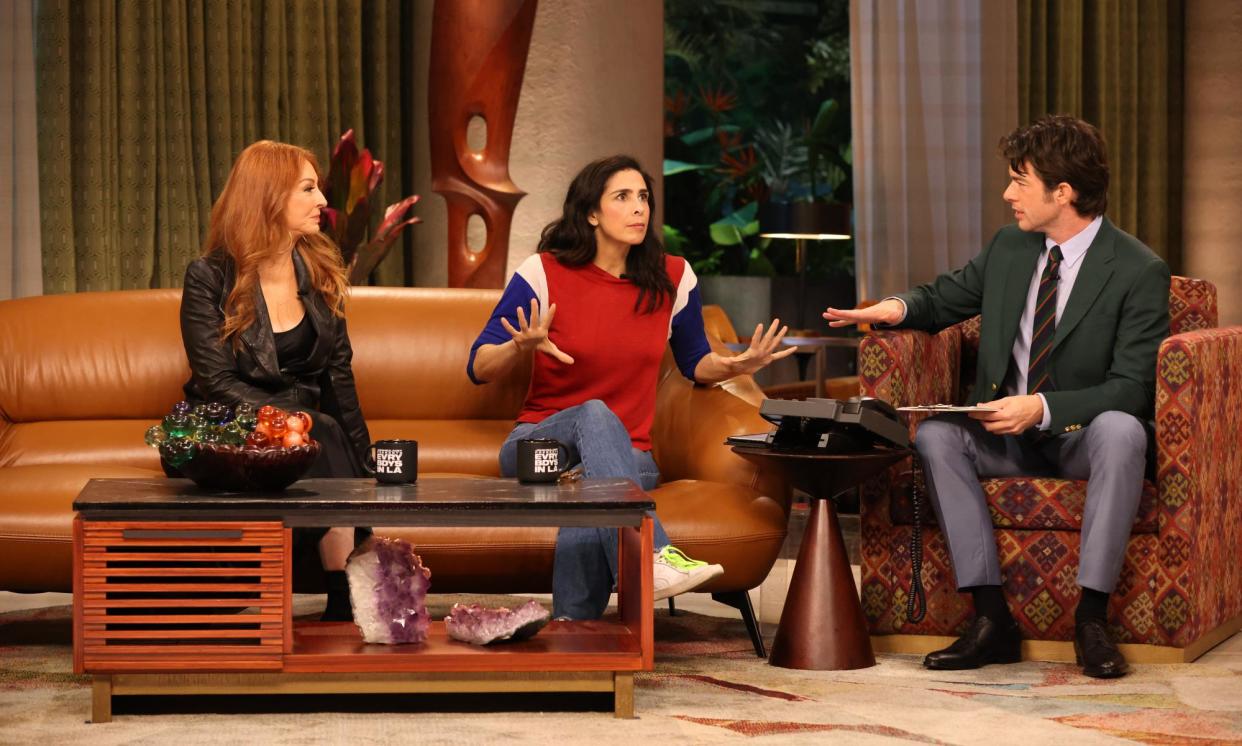The Guide #138: Netflix was supposed to have killed live TV – so why is it now embracing it?

You stumble upon the most surprising things on Netflix. The sheer size of the streaming giant – not to mention its habit for dropping new programming on to its platform with minimal fanfare – means that every now and then you’re likely encounter a show or film you didn’t see coming. An unflinchingly honest comedy drama about a Scottish standup’s experiences of being stalked, say. Or, perhaps, one of the biggest comedians on the planet hosting a celeb-packed live show themed around the flora, fauna and peculiarities of Los Angeles.
That second one, for the unfamiliar (and I’m guessing that’s many of you, as there’s been barely any attention around it) is John Mulaney Presents: Everybody’s In LA (pictured above), which has been airing for the past five nights in the US. A very loose riff on the late night talk show format – though slightly closer to Eric Andre than Jimmy Fallon – Everybody’s in LA sees Mulaney welcome both celebrity guests – Will Ferrell, Jon Stewart, Sarah Silverman – and knowledgable experts into his art deco mansion/studio to discuss a different LA-focused topic: helicopters, or palm trees or the paranormal. There are musical guests (St Vincent, Weezer, excellent punk band Joyce Manor, getting a long overdue plum TV spot), pre-recorded skits and many of the other trappings of talk shows. But everything’s just ever so slightly off; a strange semi-ironic tone that I still can’t decide whether I find off-putting or intriguing.
More intriguing than the content though is the show’s delivery method: live TV, but on Netflix. And it’s not a one-off experiment in that regard either, but a rather a concerted move in recent months from the streamer. Last weekend saw Netflix broadcast The Roast of Tom Brady, a three-hour live skewering of the former NFL quarterback by former teammates and comedians. Currently airing is Dinner Time Live With David Chang (pictured below), a weekly show where the TV chef cooks for a pair of yuk-yukking celebs (Silverman, seemingly on a never-ending merry-go-round of light entertainment shows, appears on this one too).
That’s not all. Earlier this month there was Katt Williams’s standup special Woke Foke, broadcast entirely live (something that Netflix first experimented with in a Chris Rock special last year). The Screen Actors Guild (SAG) awards were also shown live by Netflix too, as, in July, will be the truly grotesque-sounding boxing match between YouTuber turned sparrer Jake Paul and a 57-year-old, physically ailing Mike Tyson. And next year Netflix will air weekly live episodes of WWE Raw, the long-running Monday night flagship wrestling show, as part of a multibillion deal.
It’s worth underlining what an unusual development this is. Yes, plenty of streamers have dabbled in live TV – particularly sport – but this is Netflix we’re talking about. Theirs is the everything-everywhere-all-at-once model: schedules, the idea of someone sitting down to watch a specific show at a specific time, is anathema to them. While just about every other streaming service has ditched the binge-release model, Netflix, the inventors of it, have held firm. Its entire mindset has been in opposition to the idea of appointment TV – and you can’t really get more appointment TV than something that’s being broadcast live.
So what’s happening here? Are Netflix suddenly abandoning their long-held principles? Well, not quite. Ultimately its mission is in essence to replace TV, to provide everything you might have found on satellite or cable in one handy place. It would be understandable then that live programmes, still a pretty significant component of TV, would be included in that. Live television at it’s best can be electrifying in a way pre-recorded television cannot – from the dramatic live announcement of the winner of your favourite reality show to the high-wire act of doing a live episode of a show like ER.
Still, what’s particularly interesting about the sort of live TV Netflix is making is that it is designed to be rewatchable. Ultimately Netflix wants these shows to add to the war chest of content they have spent the last decade building. Those live television broadcasts like the nightly news or breakfast TV programmes, which you’re unlikely to ever revisit after they are first broadcast, are useless to Netflix. But something like The Roast of Tom Brady – which will been watched by far more people in the hours and days after it aired than those who watched it live – has value.
Everybody’s In LA takes this further, a live show essentially engineered for rewatchability. It avoids current events for a sort of strange timelessness: those topics (palm trees, the paranormal) are evergreen, there’s no standard opening late night monologue riffing on current events, and even the skits – a focus group of old punks, for example – could have worked equally well in 2014 as 2024. It means that if you stumble upon the series in the next six hours or six years, it’s likely to have the same appeal. Or as Mulaney puts it in one episode: “Pretty soon we’ll just be a little box on your homepage under the heading ‘because you watched Korean romcoms’”.
If you want to read the complete version of this newsletter please subscribe to receive The Guide in your inbox every Friday


